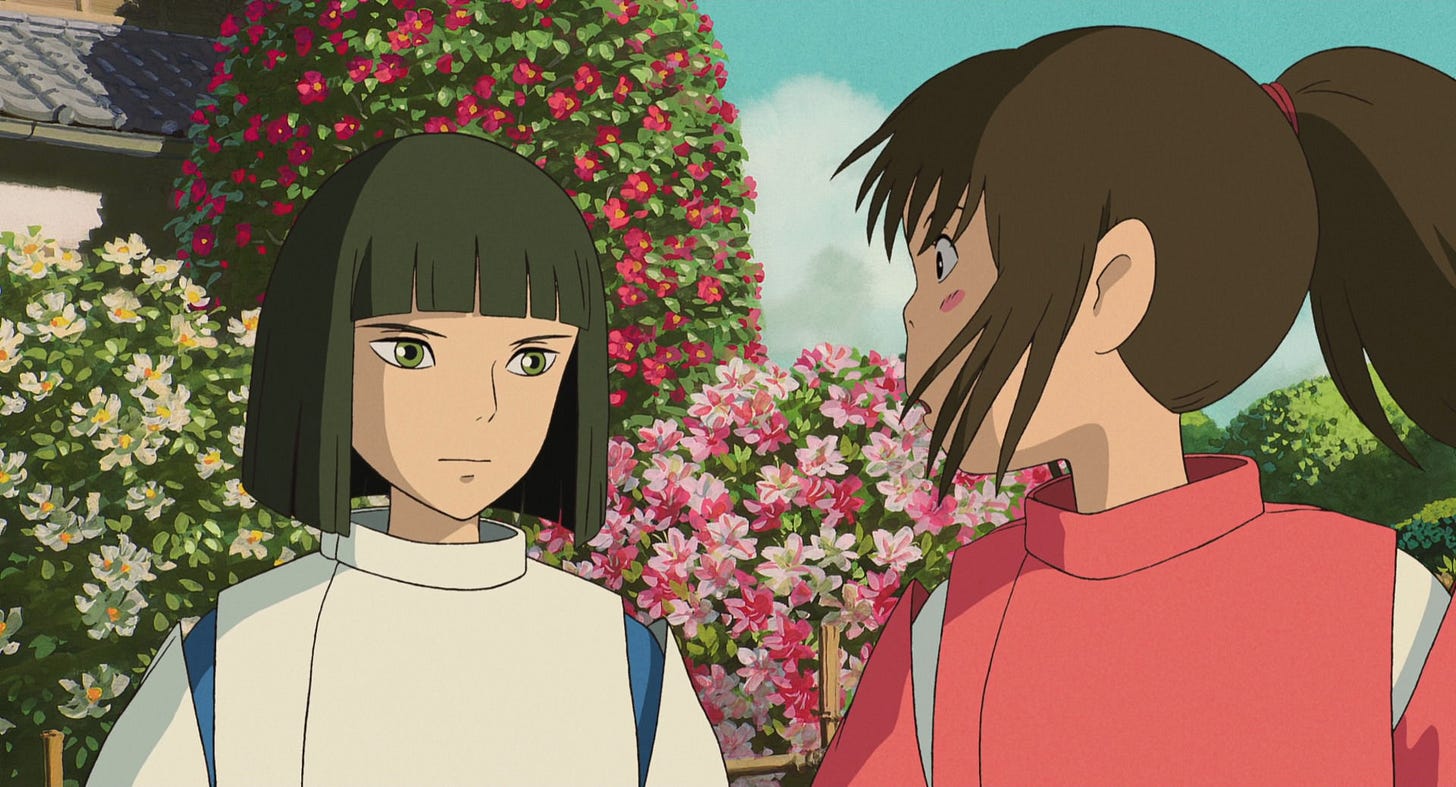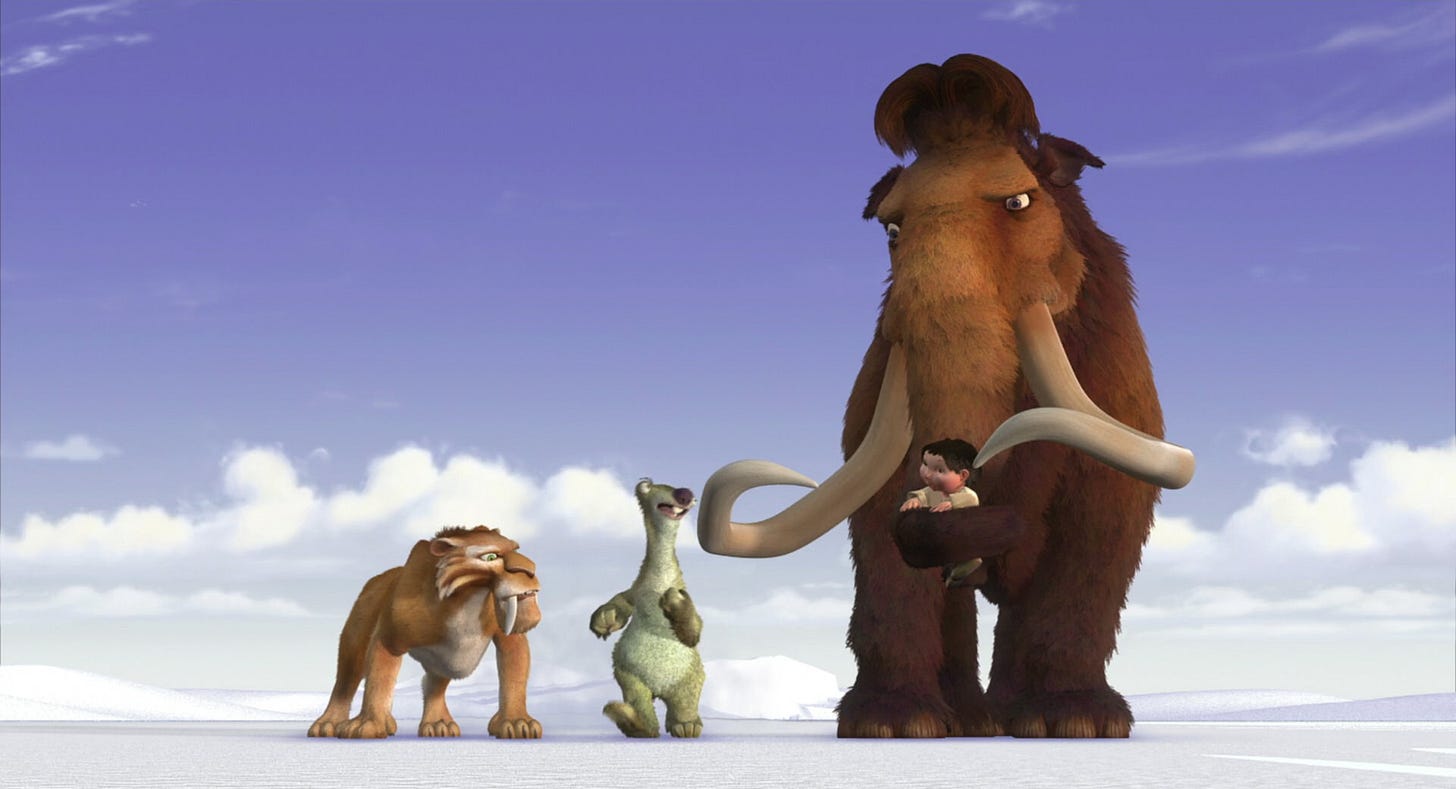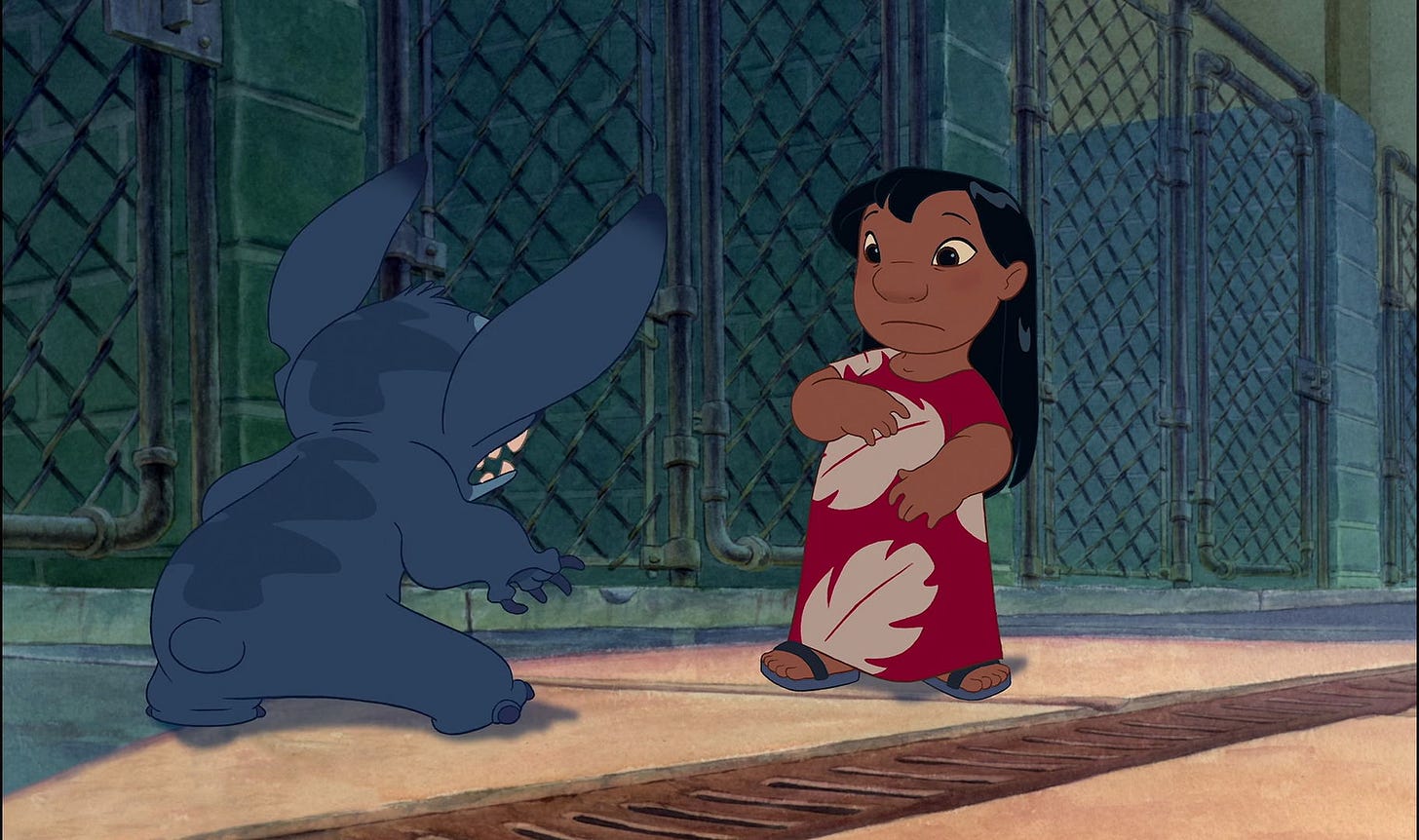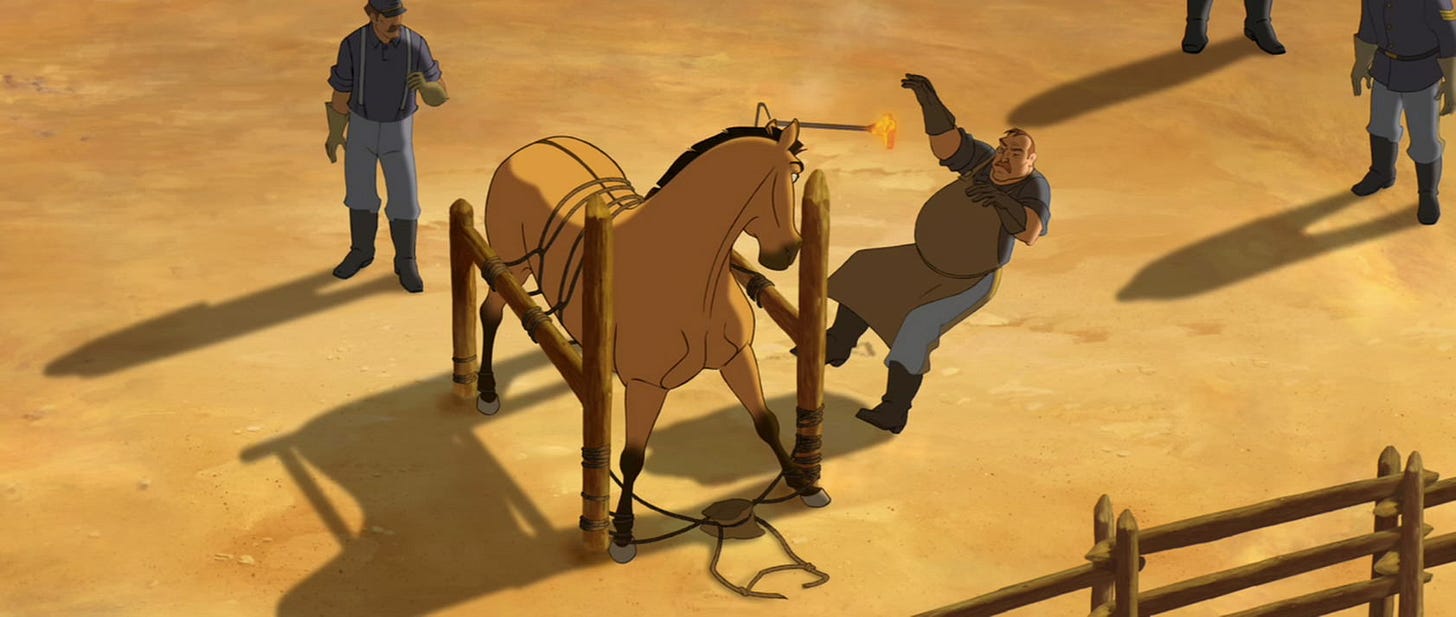Better Animated Feature: 2002
It took just two years for a foreign film to win Best Animated Feature. Was it the right choice?
This post may be too long for email. We recommend clicking through to the website for the best experience.
Leah: Looking back on 2002, the Best Animated Feature nominees capture a pivotal time in animation history: 3D animation was on its way in and 2D animation was starting to lose relevance, though not enough to prevent four 2D movies from getting nominations.
2002 has always been notable as one of the rare years when a foreign film won Best Animated Feature.1 I expect that throughout this series, we will make the case for recognizing the excellence of animations created outside the United States, but this year is particularly interesting because that case has already been made. Spirited Away is praised as one of legendary animator Hayao Miyazaki’s best films.2
How does it stack up against the competition? This was the first year with five films nominated for Best Animated Feature—a number that would eventually become the standard.
We have Ice Age, the first film from early computer animation adopters Blue Sky Studios, exemplifying animation trends of the aughts. It would go on to become a very successful franchise. There’s Lilo & Stitch, one of Disney’s last 2D-animated films and a success in its own right, and Spirit: Stallion of the Cimarron, one of DreamWorks’ last films using hand-drawn animation while also incorporating techniques from 3D animation, innovating on both techniques.
Finally, Treasure Planet was (and is) the most expensive 2D-animated film of all time, and also was an enormous flop. Terry Rossio, credited under “Story by” for Treasure Planet had this to say about the experience of working on the movie:
“The Monday after it opened, Disney had to downgrade its earnings estimates for the quarter, which dropped the value of the Disney stock. And since Disney is a member of the Dow Jones Industrials—well, let’s just say it’s a humbling experience to work on a movie that drags down the entire freakin’ world economy.”
On that note, let’s get into it!
The Nominees
Spirited Away (won Best Animated Feature)
Ice Age (nominated)
Lilo & Stitch (nominated)
Spirit: Stallion of the Cimarron (nominated)
Treasure Planet (nominated)
The “Best” Animated Feature: Spirited Away
Leah: Last year, I embarked on a journey to watch every Studio Ghibli movie. Those who read the Ghibli Gallon might remember that I put Spirited Away in the “cinematic masterpiece” tier.
The Ghibli Gallon
Having a pint of Pixar as a treat was fun, but what about gorging myself on the whole gallon of Ghibli?
After rewatching it, my rating was affirmed. From the music to the animation to the story, every aspect of this movie shows excellence in its craft.
Spirited Away tells the story of Chihiro, a young girl who finds herself trapped in a strange world of spirits. She has to find a way to escape and rescue her parents (who were turned into pigs, just roll with it). It’s hard to do the story justice in a summary of a couple sentences. It explores coming of age, love, greed, identity, and so much more. The strength and multitude of its themes are one of many reasons this movie has stood the test of time.
The visual aspect of this movie is masterfully crafted. Throughout the movie, the viewer is immersed in a magical world, full of characters that make it come alive. The atmosphere gives the viewer a distinct sense of place. I love the variety of character designs. The spirits are very creatively rendered, and who could forget the iconic design of No Face?
The character animation is also fantastic. In order to make the spirit world come alive, the animators had to be creative in portraying the movements of the characters. Even if it’s clear nothing like No Face exists in our world, it’s easy to be convinced that No Face is real in the world of Spirited Away, based on how he was brought to life by the animation.
As I rewatched Spirited Away, I noticed how integral the music was to the movie. It worked to set the mood in each scene, matching the tone and emphasizing the narrative. The score is memorable and iconic, enriching the viewing experience.
It is also important to note how influential Spirited Away was and is. Not only did it become the highest grossing movie in Japan and hold that title for nearly two decades, it also became wildly popular internationally, bringing worldwide attention to Japanese animation. Spirited Away’s impact on cinema cannot be overstated.3
With all this under consideration, it’s not surprising that this movie won Best Animated Feature. Showcasing all of the best aspects of animation in film, Spirited Away is a movie like no other. Studio Ghibli is one of the greatest animation studios of all time (if not the greatest)4 and this movie shows exactly why.
The Other Animated Features
Ice Age — Eli
Nominated
I remember liking this movie. I watched Ice Age and its 2006 sequel Ice Age: The Meltdown at least a few times as a kid.
I still remember the scene at the end of the sequel in which Scrat, the squirrel who spends the entire series chasing acorns he never gets to eat, briefly dies and goes to acorn heaven before being revived and attacking his savior in anger.
This scene has stuck with me for 18 years. It’s the first time I could remember watching something so needlessly brutal in a movie meant for kids. Don’t get me wrong, Pixar had plenty of heartstring-tugging scenes that evoked less-than-happy emotions, but…they always had a point. The nascent Blue Sky Studios didn’t. If there’s a point to this scene—a throwaway gag that has nothing to do with the plot—it’s that Scrat hates his existence on this mortal plane and wishes he could have stayed dead.
Thanks to this, my vague recollection of the Ice Age series was that it was a somewhat darker take on the classic animated kids’ movie formula. I chose to revisit the original Ice Age because I wanted to see how well that concept held up for me as an adult.
Instead, I sat through a movie that never really felt like it knew what it was trying to accomplish. You can tell the movie wants to be darker, but it also knows that being too dark will make it less profitable, so it shies away from telling a story with any real power. What we’re left with is a retread of Shrek with worse animation, a blander script, and less iconic voice acting.
At the risk of spoiling a movie old enough to drink: the climax features a battle pitting the three main characters—Manny the mammoth, Sid the sloth, and Diego the saber-toothed tiger—against the ambush of saber-tooths Diego has betrayed to help Manny and Sid on their journey. The ambush corners Manny and its leader leaps toward him to slash his throat, but Diego jumps into his path and takes the blow himself, saving Manny from certain death.
In the original cut, this hit killed Diego. But when the producers showed this to test audiences, the children unsurprisingly began bawling. So they hastily rewrote the end of the movie to feature Diego being reunited with Sid and Manny, playing his survival off with a lazy quip about having “nine lives”. This rewritten conclusion completely erases the magnitude of the “death” scene—which still looks like a death in the final cut—and is so shoddy that I could tell how the movie was supposed to end without looking it up.
Moments like this are sprinkled throughout the film, starkly interrupted by juvenile humor every now and then (including an overabundance of slapstick) to keep the kids entertained. 26-year-old me chuckled maybe three times throughout the entire experience.
I might have enjoyed the movie Blue Sky originally wanted to make, but that’s not the movie we got. What we got is a mess. It’s a bad movie. It did not deserve to win any awards over Spirited Away, which is a good movie.
Verdict: Not a better animated feature
Lilo & Stitch — Nik
Nominated
Most of the films produced by Walt Disney Animation Studios take a time period or place such as ancient China, the Savannah, or Colonial America, and stem out the story from there. Lilo & Stitch breaks that mold. Someone at Disney just thought one day, “okay, so what if we set a movie in Hawai’i, but there are also aliens?” That’s definitely an oversimplification of the premise, but despite the wacky concept, it just works.
A few years ago, I watched each movie produced by what is now Walt Disney Animation Studios. I think, growing up as someone really into animals, I had this sort of disdain for Lilo & Stitch. I was too good for a movie about a fake creature. Therefore, movies like Lion King and Brother Bear were ones I remembered liking a lot more. However, when I rewatched this movie then, and again now, it became quickly apparent that the story is much more important to a good animated movie than where it takes place.
The movie excels in appealing to multiple age groups. As a kid, this movie is innocent. While one’s younger self might pick up that Lilo and Nani’s parents are no longer with them, the story does not spend too much time focusing on this sad aspect. Many goofy and fun sequences with the famous little blue alien distract from this. To be honest, I think as a kid, all I got from this movie was that the aliens wanted to take Stitch home and Lilo helped him calm down and show he could be better.
As an adult, I feel as if the movie should be called Lilo & Stitch & Nani. Nani is an incredibly underrated Disney character and the unspoken hero of the film. Hidden behind the two main characters is her incredibly sad undertone. All Nani wants is to show that she can be a good sister and take care of Lilo, because Lilo is all she has left.
Where kids see this annoying older sister, adults see a character that is not loud and mean for no reason. She just deeply cares and is scared of having her sister taken away.
You’d expect a Disney film set in Hawai’i to have a soundtrack mostly focused on culturally relevant music, right? Well, there are definitely songs that focus on this theme, but what type of music does a Hawai’ian-Space movie need the most? That's right: seven songs by Elvis. That said, the movie’s integration of Elvis is fairly subtle, which is definitely an underrated aspect.
Lilo & Stitch may be the easiest Disney film to watch over and over. It is heartwarming, but not heart-wrenching. It’s not laugh out loud humor, but it has you smiling the whole time. Most importantly, it appeals to all audiences in one way or another. Spirited Away is a fantastic movie in its own right. However, if I am basing my decision on overall appeal and continuous watchability, Lilo & Stitch is unrivaled.
Verdict: Better Animated Feature
Spirit: Stallion of the Cimarron — Leah
Nominated
Before I started this project, I decided I would look for the good in every movie that I watched and present the case for why it could win Best Animated Feature. Surely every movie was nominated for a reason, and even the worst of them must have something redeeming, right? Well, luckily for me, my 2002 nominee, Spirit: Stallion of the Cimarron, is a good movie that has a lot going for it.
Because this movie came out in 2002, I was the correct age to be in the target audience. I didn’t remember much from when I saw it the first time as a child, so I was pleasantly surprised revisiting it with an adult perspective.
The movie follows a wild horse living with his herd in the Wild West. He gets tangled up with the U.S. Army, who capture him and try to “break” him. While in captivity, a young Lakota man named Little Creek is also captured by the Army. Little Creek helps Spirit escape and brings him back to his village.
I think it’s noteworthy that an animated kids’ movie in 2002 had such strong anti-colonization themes. It makes it clear that the actions the U.S. Army takes to settle the West are harmful and wrong—especially their attack on the Lakota village and their attempt to build a railroad through Spirit’s homeland. Obviously a movie meant for children that’s told from the perspective of a horse isn’t going to be the end-all-be-all deconstruction of colonization in the United States, but it’s important to have movies that can introduce children to these difficult concepts, and this is definitely one of them.
I referenced this in the intro, but Spirit also used techniques from both 2D hand-drawn animation and 3D computer-generated animation. In this way, it was ahead of its time; years later, people would praise animations like Paperman and Klaus for blending 2D and 3D together in an innovative way. I do think some of Spirit’s 3D elements look dated today, but in the context of 2002, I can’t knock the movie too hard for this. They chose a very ambitious process to make an animated film, and trying new techniques can only advance the medium.
I’d also be remiss if I didn’t mention how hard horses are to draw—seriously, ask any artist who draws animals about how horses compare to other creatures, and they’ll tell you. So it’s pretty darn impressive that DreamWorks animated a movie that not only heavily featured horses, but also had the horses express themselves purely through body language and neighs. We get some voiceover narration from Spirit’s perspective, but the viewer sees Spirit act like a horse (and communicate with other horses like a horse). It’s a fresh take on anthropomorphic animal movies.
Overall, I think the movie’s narrative is solid. It’s not groundbreaking, but it is well-constructed, and it works well enough to entertain the target audience.
I will say that the soundtrack of the movie definitely screams “2002”—DreamWorks’ use of popular music did date them here—though overall, I thought the soundtrack was fine, with a few songs I really liked (“Here I Am”, “Get Off My Back”). It definitely didn’t reach the timelessness of Spirited Away’s soundtrack though.
Speaking of Spirited Away, how does Spirit: Stallion of the Cimarron compare to that movie specifically? I’ve laid out Spirit’s positives, but winning the award doesn’t just mean the movie is good in it’s own right; it means it’s the best. And, though I do believe Spirit deserves some recognition and accolades, I don’t believe it’s a better movie than Spirited Away.
Narratively, Spirit just doesn’t hold a candle to the complexity of Spirited Away. The former has a good story and is an achievement of animation, but the latter is a cinematic masterpiece, influencing audiences and films around the world. The influence of the two movies, of their effects on the larger culture, isn’t comparable.
Spirit deserved the recognition of the nomination, but ultimately, it doesn’t outshine Spirited Away.
Verdict: Not a better animated feature
Treasure Planet — Preston
Nominated
Treasure Planet is a good enough movie. It’s largely unobjectionable—arguably even more than its predecessor in Disney’s 2D discography, Atlantis: The Lost Empire—and if the fundamental concept appeals to you, it’s probably a worthwhile watch. It probably doesn’t deserve the reputation as, effectively, the final nail in the coffin before Disney’s full move into 3D; this was the beginning of the end, but there would be a few more films in the traditional style. It’s not nearly bad enough to have earned that albatross around its neck, and its poor performance at the box office (not helped by opening against Harry Potter and the Sorcerer’s Stone) is the only really strong point against it.
But “good enough” is, pretty broadly, the correct way to describe Treasure Planet. It’s not only an adaptation of an existing story (Robert Louis Stevenson’s Treasure Island), it’s both the third adaptation specifically into a science-fiction setting and the third adaptation by Disney itself. For the most part, it hits every beat you’d expect and very rarely surprises you—and I say this without having read the story it’s adapted from. After about thirty minutes, it’s pretty clear where the final hour and change of the film is headed.
This isn’t, in and of itself, a bad thing; you could say it about a lot of previous films during the Disney Renaissance. Co-writers, producers, and directors John Musker and Ron Clements worked on Treasure Planet following their work on Hercules, for example, which also charts a pretty clear roadmap early on and rarely deviates from it. More than anything, what makes Treasure Planet struggle to live up to those lofty standards is a lack of the polish that should be expected of Disney.
The animation has moments of brilliance, but is also a worse offender of the early-2000s “bringing 3D sequences into 2D animation” trend than just about anything else I’ve seen. The script has some genuinely heartwarming and endearing moments, but also feels unbearably clunky for long stretches. The movie isn’t bad by any stretch of the imagination, but watching a film from this studio, with this dynamic duo overseeing the project…it’s hard not to imagine how much better it could have been.
Two highlights are worth noting in an otherwise fairly typical story—which, as it happens, align nicely with the two main highlights of Atlantis, a sister film to this one in many ways. As in that story, the characterization and arc of the “twist” villain (though this one hardly qualifies for that descriptor) is fantastic, done even better here with John Silver. In an otherwise very predictable plot, he feels genuinely unpredictable at almost every moment, one of the most convincing portrayals of a conflicted antihero ever put to film. The late Brian Murray’s vocal performance in the role deserves particular commendation, as does the animation—two elements which combine to bring the character to life in a movie that would feel almost lifeless without him.
Also as with Atlantis, I’d argue Treasure Planet is worth seeing for the finale alone. It’s one of the most breathtaking visual sequences Disney has ever produced, before or after the transition to 3D, and it somehow manages to one-up a climax that featured an airship escape from an erupting volcano. It stings that this was both a swan song and a death knell for the studio’s 2D era, but even if it had ended on the spot, this scene would’ve been a fitting note to send it out on.
Treasure Planet is a fun watch. If you’re into anything it has to offer, it’s an easy recommendation and has more than earned its cult-classic status. But the question is whether it deserves the Oscar this year. Was it, indeed, a better animated feature?
Um. You saw what it was up against, right?
Verdict: Not a better animated feature
Running Tally
2001: 2 better (2 nominated; 3 snubbed)
2002: 1 better (4 nominated; 0 snubbed)
TOTAL: 3 better (6 nominated; 3 snubbed)
Join us in two weeks, when we discuss Pixar’s first win, Finding Nemo, and decide whether any of 2003’s other finest animated films deserved to beat it!
Next: 2003 (2 nominated; 2 snubbed)
Ghibli’s latest film, The Boy and the Heron, won the 2023 award after I wrote this intro. Ghibli stays winning!
Fun fact: Miyazaki is tied with Pete Docter as the directors with the most Best Animated Feature nominees, with four.
Definitely read the TIME article linked above to learn more; I just summarized the highlights.
Leah hot take alert















Commenting before reading, a major faux pas, but Spirited Away is one of the best FILMS ever, animated or otherwise.